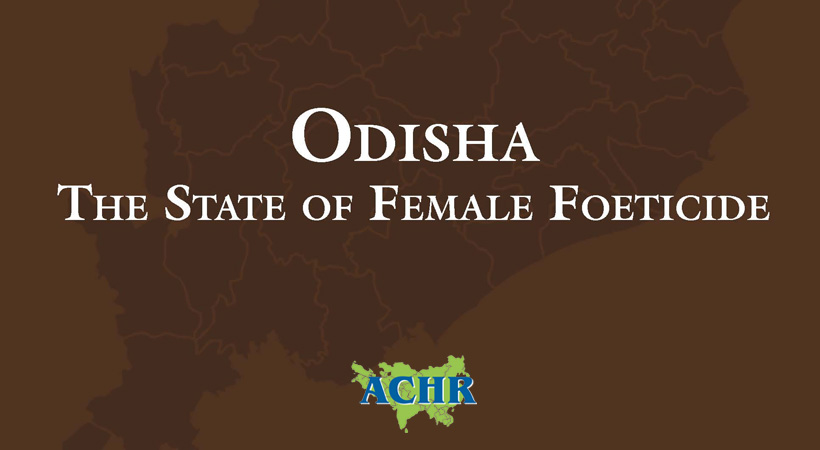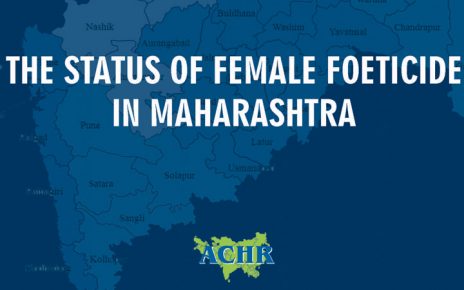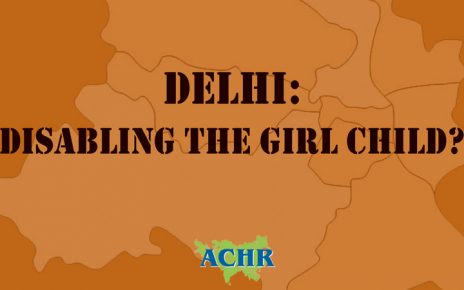In Odisha, the Child Sex Ratio (CSR) has been consistently falling as reflected from the census data: 1035 in 1961, 1020 in 1971, 995 in 1981, 967 in 1991, 953 in 2001 and 941 in 2011. In terms of point, the CSR fell by 54 points from 1981 i.e. period before widespread use of technology for sex selection to 2011. With the CSR of 941 as per 2011 census, Odisha ranked 19th in skewed CSR among 35 States and Union Territories (UTs) of India.
Though the CSR of Odisha at 941 as per 2011 census does not appear to be as acute as in many States of North India, the following ought to be borne in mind. First, the CSR in Odisha had been above natural sex ratio of 105 males for every 100 females as estimated by the World Health Organisation but it has been consistently falling especially since 1981. Second, the fall in the CSR during 2001 to 2011 was across the spectrum: the CSR declined in 26 out of 30 districts of the State. Third, the fall in the CSR of certain districts during 2001 to 2011 has been drastic with Dhenkanal district witnessing the highest fall (decrease in 55 points) followed by Nayagarh district and Angul district (53 points each), Ganjam (40 points), among others. The CSR in Nayagarh (855), Dhenkanal (870), Angul (884) and Ganjam (899) districts was much lower than the State CSR (941) and national CSR (919). Fourth, as per 2011 census, the CSR in urban areas (913) remained much below the rural areas (946) indicating access to technology as a key contributing factor for the declining CSR.
The Director of Family Welfare-cum-State Appropriate Authority under the Preconception and Pre-Natal Diagnostic Techniques (Prohibition of Sex Selection) Act, 1994 (PC&PNDT Act) attributed decline in the CSR to sex selection with misuse of modern diagnostic techniques like invasive method of amniocentesis and non-invasive method like ultra-sonography at preconception and prenatal level.
The reasons are not hard to find as highlighted below.
First, female foeticide was so rampant that in July 2007, police recovered over a dozen female foetuses packed in plastic containers from a drain behind the Bhubaneswar Diagnostic and Ultrasound Clinic, located near Naveen Nivas, the residence of Chief Minister Naveen Patnaik. In July 2007 itself, police further recovered about 160 female and decomposed fetuses in another two separate incidents in Nayagarh district.
Second, despite such rampant female foeticide, the PC&PNDT Act is actually violated with impunity in Odisha with the State Government turning its blind eye with respect to enforcement of the Act especially registration of the cases. The Comptroller and Auditor General of India (CAG) in Audit Report titled, “Report No. 2 of 2015 Report of the Comptroller and Auditor General of India on General and Social Sector for the year ended March 2014 Government of Odisha” highlighted blatant violations of each and every provision of the PC&PNDT Act and at each and every stage. The CAG highlighted (a) ineffective functioning of various authorities under the PC&PNDT Act, (b) unauthorised functioning of ultrasound clinics, (c) registration and renewal without inspection, (d) ultrasound being conducted by unauthorised person, (e) non-surrender of certificates of registration by defunct ultrasound centre, (f) absence of regular inspection of ultrasound clinics, (g) no mechanism to track portable USG machines and their use, (h) non-maintenance of prescribed records, (i) non-filing of Form-F by ultrasound clinics and nontracking of pregnant mothers, (j) failure of the decoy customer scheme, (k) no enquiry in case of specific complaints of violations and sex determination, (l) non-implementation of recommendations of the State Supervisory Board, and (m) non submission of quarterly sales list by dealers and affidavit by the purchasers. The result has been the lack of conviction under the Act: from inception in 1994 to 31 March 2015, only 51 cases were filed in the courts out of which 20 cases were pending adjudication, 3 resulted in convictions and 28 resulted in acquittal.
Third, unlike Madhya Pradesh, Bihar, Rajasthan, Punjab, Delhi, Andhra Pradesh, Himachal Pradesh which had launched specific schemes for retention of the girl child in order to address the falling CSR, it was only in September 2016 that the Government of Odisha launched the Biju Kanya Ratna Yojana (BKRY) for implementation in Ganjam, Dhenkanal and Angul districts on a pilot basis for a period of three years to improve Sex Ratio at Birth (SRB) and the CSR. Strangely, Nayagarh district which had the lowest CSR (855) in Odisha has been excluded from the BKRY!
Odisha consistently lacked seriousness to arrest falling CSR. In 2012, it launched a scheme to conduct decoy or sting operations to nab those involved in sex selection and it announced Rs 5,000 as reward. Indeed, one successful decoy operation was conducted in Angul district in September 2012. The State Government itself acknowledged that “the money offered is negligible and this turns away most volunteers”. Yet, the Government of Odisha instead of increasing the reward money altogether abandoned the programme on sting operations involving the decoys!
The lack of seriousness of Odisha for implementation of the PC&PNDT Act further stands exposed from the failure to act upon the recommendations of the CAG, the focus of the BKRY only on three districts on a pilot basis, that too only for a period of three years, and the exclusion of the most gender critical district, Nayagarh from the BKRY. The violations of the PC&PNDT Act are so rampant that during 2014-2015 the Appropriate Authorities inspected 15 premises in the districts of Dhenkanal, Cuttack, Khordha, Kendrapara, Puri and Balasore and had to register 14 complaint cases. It implies that in almost 100% of the cases, the AAs found violations of the PC&PNDT Act.
Conclusion and recommendations
If Odisha is to address decline in the CSR, it ought to fully enforce the PC&PNDT Act and improvise the BKRY.
Asian Centre for Human Rights (ACHR) recommends the following to the State Government of Odisha:
- PC&PNDT Act:
– Establish PC&PNDT Bureau of Investigation under the Department of Health and Family Welfare to assist the appropriate authorities for effective implementation of the PC&PNDT Act;
– Launch a Mukhbir Yojana to reward those providing information with amount of rewards of at least Rs 200,000 to decoys and Mukhbirs along with (i) specific incentive in the form of bond/scheme for the unborn baby of the decoy customer apart from undertaking of not aborting the foetus under any circumstances; (ii) specific allowance to the decoys and Mukhbirs to attend each hearing during the trials; (iii) ensure anonymity of the complainants, informers etc to the extent possible; and (iv) sanction adequate financial resources for implementation of the scheme;
– Ensure proper implementation of the PC&PNDT Act inter alia through: (i) ensuring efficient and effective system of registration of all ultrasound/ genetic clinics so as to ensure compliance to the provisions of the Act; (iii) ensuring regular and effective inspection of the ultrasound/ genetic clinics for curbing the violation of Act & Rule; and (iii) introducing Integrated Monitoring System for the PC&PNDT Act and installing tracking devices in all sonography machines;
– Ensure proper implementation of the PC&PNDT Act and Rules, inter alia, by filing cases against (i)unauthorised functioning of ultrasound clinics, (ii) ultrasound being conducted by unauthorised person, (iii) non-surrender of certificates of registration by defunct ultrasound centre, (iii) use of portable USG machines and their use, (iv) nonmaintenance of prescribed records, (v) non-filing of Form-F by ultrasound clinics, (vi) non submission of quarterly sales list by dealers and affidavit by the purchasers, and (vii) ensuring time bound trial of the cases under the PC&PNDT Act
– Ensure departmental actions against the Appropriate Authorities for the failure to ensure compliance with the PC&PNDT Act and the Rules; and
– Make necessary budgetary allocations for implementation of all these measures.
- Biju Kanya Ratna Yojana
– Extend the Biju Kanya Ratna Yojana in all the districts which have CSR below national level CSR (919) as per 2011 census i.e. Nayagarh (855), Khurda (910), Cuttack (910) and Deogarh (917).
– Revise the Biju Kanya Ratna Yojana to (i) cover all the districts of Odisha, (ii) increase the amount for post birth benefits of at least Rs. 1 lakh, educational scholarship of Rs. 50,000, provide additional financial assistance of Rs. 1 lakh to be paid to surviving girls for assistance during marriage; and (iii) link implementation of the Scheme with Anganwadi centres and hospitals;
– Upload all details of physical and financial achievements under the proposed scheme on a dedicated website and update the website regularly to provide all relevant information such as list of beneficiaries, funds sanctioned and utilization certificates;




